Can I Ship Camera With Rechargable Battery
Lithium batteries, especially lithium-ion batteries, have go a preferred energy source for many items due to their high power density and calorie-free weight likewise as their rechargeable capability. Lithium batteries can be institute in most consumer electronic items such equally smart phones, laptops, and tablets besides every bit larger items such as portable power tools, portable vacuum cleaners and e-bikes. Still, many people accept no idea that lithium batteries are classified as dangerous appurtenances. With the increasing need for electronic devices, the number of lithium batteries being shipped increases too.
What are Lithium Batteries?
The term "lithium battery" refers to a family of batteries with dissimilar chemistries. For the purposes of the unsafe goods regulations they are separated into two types of batteries: lithium metallic and lithium-ion.
What Is the Difference Between Lithium-ion and Lithium Metallic Batteries?
While both types of lithium batteries have similarities, their differences are noteworthy. Lithium metallic batteries contain metallic lithium and are primarily non-rechargeable. They have lithium metal or lithium compounds as an anode. Included in this group are lithium alloy batteries.
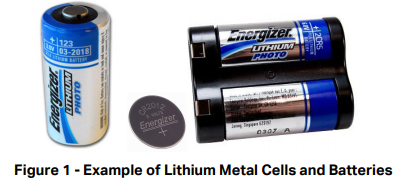
On the other hand, lithium-ion batteries are rechargeable, and lithium is only nowadays in the electrolyte in the ionic form. Included in the lithium-ion category are lithium polymer batteries. Lithium batteries are sometimes abbreviated Li-ion batteries.
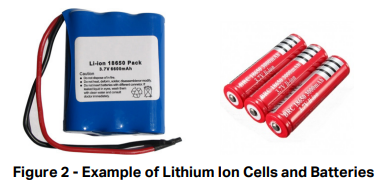
What are Lithium Batteries used for?
As lithium batteries are the preferred power source for most consumer and portable electronic devices, lithium batteries are found everywhere. They are in items you may not have even considered. Lithium metal batteries are found in items such every bit watches, calculators, cameras, motorcar cardinal fobs, and defibrillators. Lithium-ion batteries are more often than not constitute in products such as mobile telephones, laptop computers, tablets, ability tools, and e-bikes. They are in everyday items carried by airline passengers and are transported every bit cargo every day.
Tin Lithium Batteries be shipped by air?
Despite lithium battery shipping restrictions, lithium batteries can be shipped by air but non without stipulations. Lithium metal batteries shipped by themselves (meaning lone and not installed in a device or packed with the device they will power) are forbidden to exist shipped as cargo on a rider aircraft.
Lithium-ion batteries shipped by themselves must be shipped at a land of accuse non exceeding thirty% of their rated chapters. Lithium batteries are dangerous goods, and all of the regulatory requirements must be complied with, as set out in the Lithium Bombardment Shipping Regulations. In the United States, failure to comply with these regulations tin outcome in a ceremonious penalty of up to $27,000 per offence (LBSR i.iii).
Aircraft lithium batteries by air is possible, but information technology is crucial to annotation these are unsafe goods and the applicable regulations must be complied with to ensure the condom of all personnel, aircraft, and passengers.
What to know when shipping Lithium Batteries by air?
When shipping lithium batteries by air, you must follow some basic rules. Information technology is important to closely follow these regulations for the rubber of all involved. Yous will detect all of the required steps and guidelines in IATA'due south Lithium Battery Shipping Regulations manual.
Download a sample of IATA's Shipper's Checklist for a Lithium Battery Shipment
The recommended checklist is intended to aid shippers verify shipments prior to tendering the consignment.
How to transport Lithium Batteries
Lithium batteries may exist shipped by air when all the applicable regulatory requirements are met. This includes making certain that:
- The jail cell and bombardment types take passed the applicable United nations tests
- All terminals are protected against short circuits
- Packaging limits are met
- Appropriate inner and outer packaging is used
- packages behave the required marks and labels
- The required documentation is completed
What shippers should know about aircraft Lithium Batteries by air?
Shipping apocryphal or substandard lithium batteries is not adequate. To assist shippers of lithium batteries, including equipment with installed lithium batteries, a requirement came into strength with event Jan 1, 2019 that manufacturers and subsequent distributors of lithium cells and batteries must make bachelor a test summary that provides show that the jail cell or battery blazon has met the requirements of the United nations Transmission of Tests and Criteria, Part 3, subsection 38.three.
IATA Director General Willie Walsh says, "Nosotros all know how unsafe these batteries tin can be-they ignite-and clearly ensuring we tin can transport these devices safely on board is a main focus for IATA."
Information technology is important that every bit a shipper, you take the necessary precautions and strictly follow the regulations when preparing your lithium bombardment shipments to ensure the condom of the aircraft and all on board. Lithium battery shipments should always be packaged to come across all condom regulations to avoid whatsoever possible damage or fines.
Land and operator variations
States and operators (airlines) may advise of more restrictive requirements to the IATA Dangerous Goods Regulations. These requirements are published in the DGR and the Lithium battery Aircraft Regulations as Country and operator variations. These variations may limit the carriage of lithium batteries. You should contact the airline prior to offering the lithium battery shipment for ship to make certain all requirements are being met prior to transport.
Identification
When aircraft unsafe goods, they must be identified by the applicative UN or ID number, proper shipping proper name, course or division, and packing grouping (if applicable). The Un number is a 4-digit number assigned past the United nations to substances and articles and is denoted by the prefix United nations. The following (2) classification flowcharts are intended to provide guidance on the nomenclature for lithium ion and lithium metal batteries.
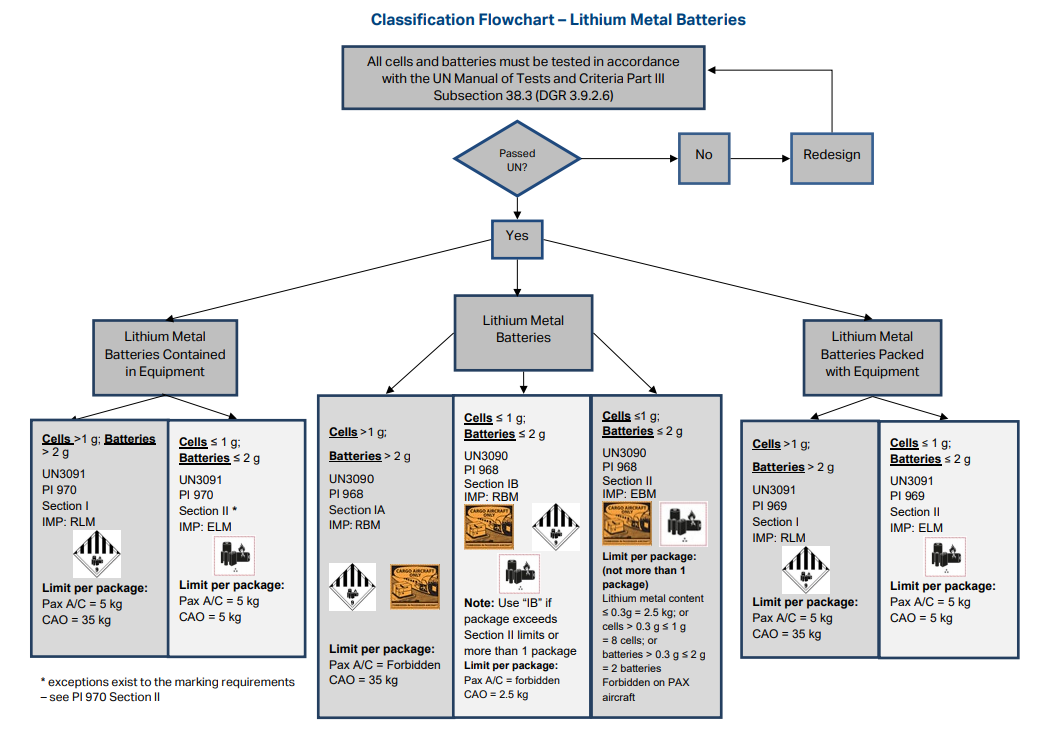
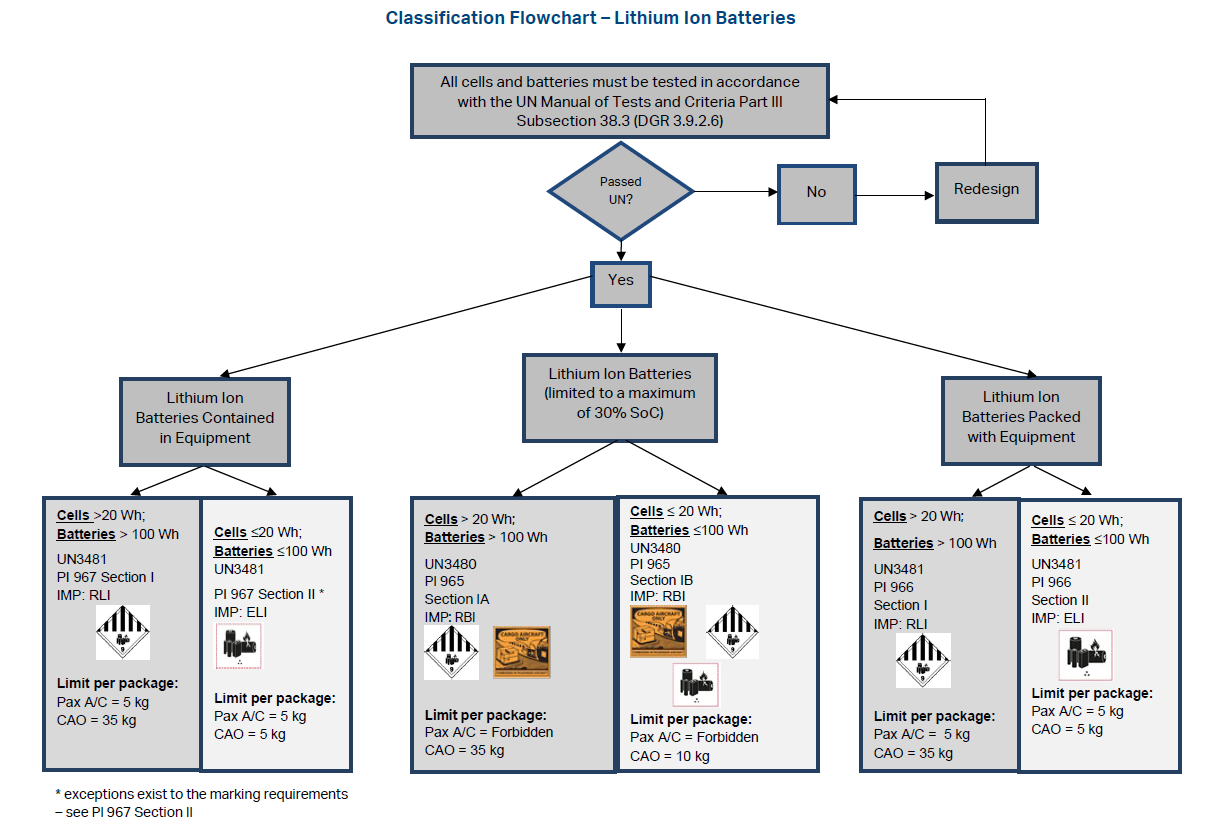
How to packet Lithium Batteries for aircraft by air
Depending on the Watt-hour rating for lithium ion cells or batteries or the lithium metal content for lithium mettal cells or batteries, the packaging required may demand to be Un specification or may exist merely strong, rigid packaging that is strong plenty to withstand the shocks, mechanical treatment, and loading encountered in transport. Shippers are besides required to take into account other dangerous goods that may be shipped with lithium batteries to ensure that in that location is no incompatibility. Such equally not packing lithium batteries with flammable liquids in the same package or overpack.
It is essential to follow the net quantity limits when shipping lithium batteries. A tabular array in the Lithium Battery Shipping Regulations manual gives the precise weight of batteries per package on both cargo and rider aircraft. All marks and labels must exist clearly visible on the exterior of all packages and overpacks.
Marking and labeling
Proper mark and labeling is required when aircraft lithium batteries by air. Marker and labeling packages containing dangerous goods informs every person involved in its transport of what is within the package and how to properly handle it during shipment, where to place it during ship, and how to address the situation if something goes wrong.
All marks must exist
- Durably applied or printed on the package
- Visible and legible
- Able to withstand the elements
- Displayed on a background of contrasting colour
- In English language. Other languages may be used in addition, when required
- Properly sized
The lithium battery mark, as shown beneath, must be applied to packages as outlined in the Lithium Bombardment Aircraft Regulations manual.
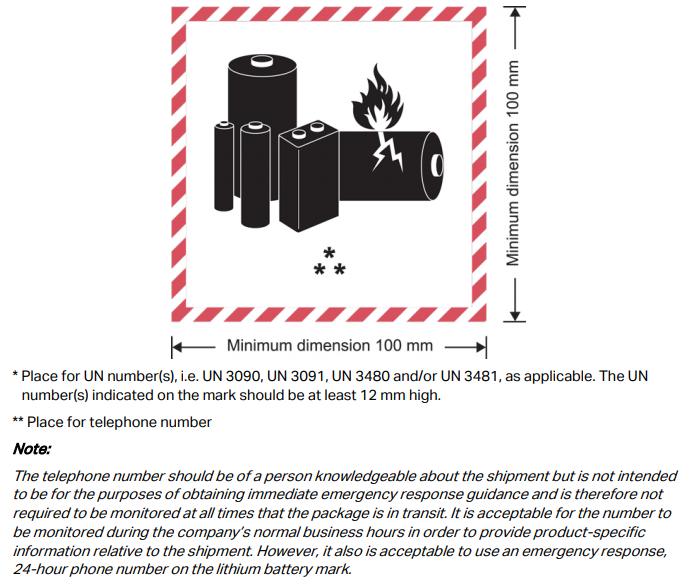
Documentation
When shipping dangerous goods by air, the appropriate documentation must be provided past the shipper to depict the unsafe appurtenances being offered. The Shipper's Declaration for Dangerous Goods must exist completed by the shipper for most unsafe goods offered for air transport. It is required that each field exist filled out properly and legibly. The fields of the document are:
- Shipper name and address
- Consignee name and address
- Air Waybill Number (generally completed by the freight forwarder)
- Folio of pages numbers
- Shipping Limitations
- Drome of Deviation (optional)
- Airport of Destination (optional)
- Shipment Type
- Nature and Quantity of Unsafe Goods
- Number and Type of Packaging
- Packing Instructions
- Authorizations
- Boosted Handling Data
- Certification Statement
- Name of Signatory
- Appointment
- Signature
In addition to the Shipper's Declaration is the air waybill. The air waybill is the contract of carriage between the shipper and the airline for the transport of the air cargo, which will back-trail the shipment as it moves through the aircraft process from shipper to consignee.
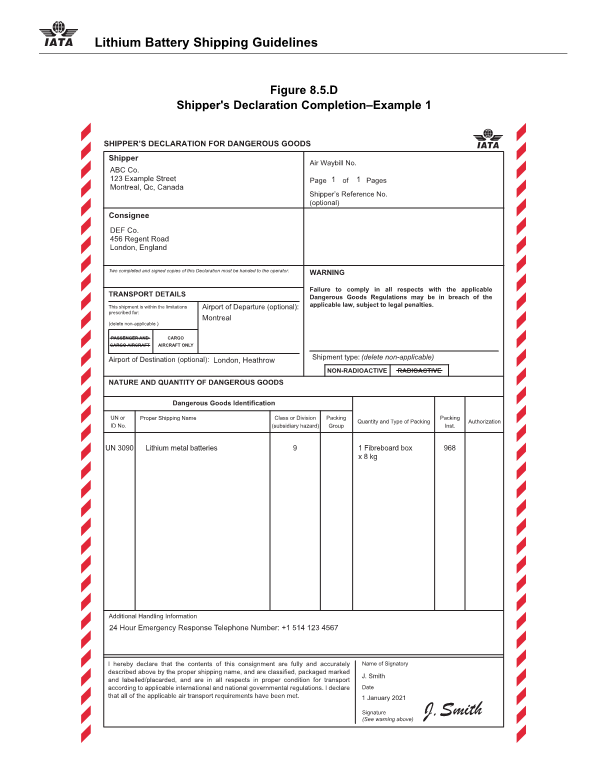
Lithium Batteries FAQs
- Wouldn't it be better and simpler just to ban all lithium batteries? Isn't that what the shipping manufacturers recommended?
Banning lithium batteries only prevents those who comply with properly shipping lithium batteries by air, non those who are non-compliant. Enforcing a ban would requite a simulated sense of security. It is better to allow for lithium battery shipments in accordance with the regulatory requirements which provide for appropriate safety measures.
- How tin can the airline be sure that lithium batteries offered for transport every bit cargo are existence declared and packed correctly, at the correct state of charge?
As with all unsafe goods, it is the shipper'south responsibility to comply with the regulations, which includes a annunciation that they have prepared the goods in accord with the dangerous goods regulations. The airlines accept the legal proclamation every bit show that the lithium batteries are, in fact, beingness shipped co-ordinate to all regulations. If they are establish not to be, then it is the responsibility of the regulatory authorities to take action.
- Can ability banks be carried, including those installed in "smart luggage"?
These are considered spare lithium batteries and must be in carry-on baggage. They are forbidden from checked baggage. Ability banks installed in baggage must exist removable. If it cannot be removed, so information technology is forbidden from being carried on the shipping. "Smart baggage" may contain pocket-sized lithium cells or batteries with no more than 0.3 thou of lithium metal or a Watt-hr rating not exceeding 2.7 Watt-hour to power scales, locks, or tracking devices. All tracking devices must automatically shut down during flight.
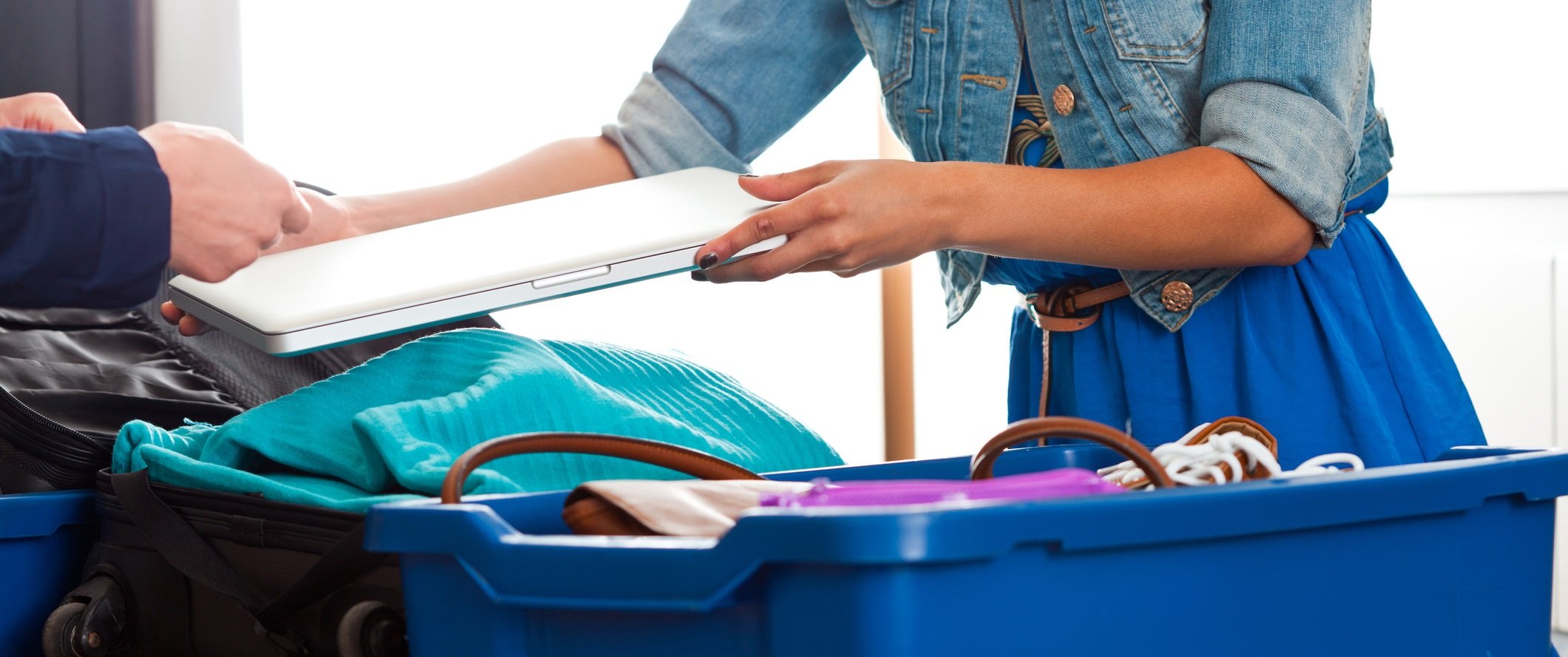
- Can Dangerous Goods be carried by passengers?
Some dangerous goods tin only be transported on an aircraft if a competent person or system properly pack them. These items are listed in the IATA Dangerous Goods Regulations (DGR) and must be prepared, labeled and alleged in accordance with them.
Yet, some items listed in the regulations may exist carried onboard the aircraft by passengers and coiffure if they fulfill the listed restrictions and limitations. Table two.3.A of the DGR summarizes the information for items of dangerous goods that may be carried past passengers in checked and/or carry-on baggage.
This tin can include items such as lithium batteries in personal electronic devices, which can be carried by passengers. It is important to know what items tin be carried on the person, like cellular phones or in carry-on luggage similar e-cigarettes. Not all lithium batteries are created equal, and knowing the divergence is important. If yous have what might be considered dangerous goods, it is always best to cheque with the airlines to run into what is allowable beforehand. You can besides consult the IATA Dangerous Appurtenances Rider Corner for more information.
- What are the requirements for portable electronic devices (PEDs), and can they be in checked baggage or carried on in the cabin?
Spare lithium batteries, power banks, and e-cigarettes must be carried in hand luggage. These are forbidden in checked baggage.
IATA recommends that PEDs be carried in the cabin, notwithstanding if PEDs are placed in checked luggage, measures must exist taken to protect the device from damage and to forestall unintentional activation. The device must be turned off, non placed in sleep or hibernation fashion.
Why Dangerous Goods training is necessary
Unsafe goods training for shippers and all other entities in the air cargo supply chain is required so that all persons that perform functions aimed at ensuring that dangerous goods are transported in accord with these Regulations are competent to perform the functions for which they are responsible. The training supports the safety objectives of air send. This dangerous goods training must be renewed every 2 years. For companies that only transport lithium batteries, or products packaged with or containing lithium batteries is information technology more appropriate to take the Aircraft Lithium Batteries by Air course to get a comprehensive look at how to ship lithium batteries and how to properly run into the requirements set out in the IATA Unsafe Goods Regulations.
Where to find more than information
IATA provides the most comprehensive guide to international air transport regulations for shipping lithium batteries by air in their Lithium Battery Shipping Regulations transmission. Navigating the rules surrounding how to ship lithium batteries tin exist complicated, but IATA'due south manuals simplify the circuitous task in easy step-by-step processes. IATA.org is a valuable resource for other safety manuals and guidance documents.
Source: https://www.iata.org/en/publications/newsletters/iata-knowledge-hub/what-to-know-about-how-to-ship-lithium-batteries/
Posted by: richardsniumor1935.blogspot.com

0 Response to "Can I Ship Camera With Rechargable Battery"
Post a Comment